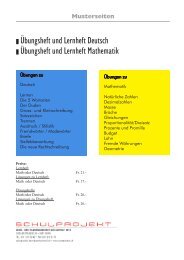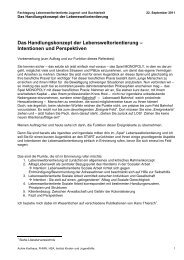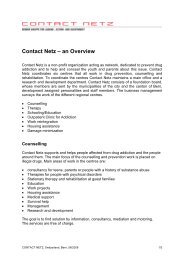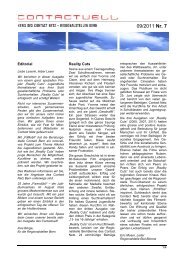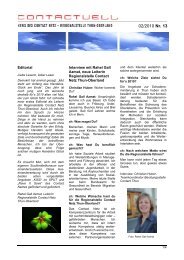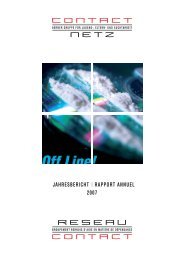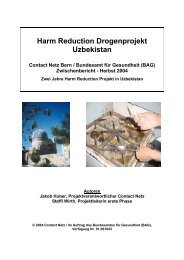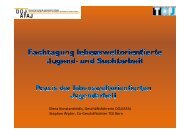Harm Reduction Drug Project Uzbekistan - Contact Netz
Harm Reduction Drug Project Uzbekistan - Contact Netz
Harm Reduction Drug Project Uzbekistan - Contact Netz
You also want an ePaper? Increase the reach of your titles
YUMPU automatically turns print PDFs into web optimized ePapers that Google loves.
10. Conclusions and new challenges<br />
The <strong>Uzbekistan</strong>-Switzerland <strong>Harm</strong> <strong>Reduction</strong> Model <strong>Project</strong> has started something<br />
big. It has proved the advantages and limitations of an efficient syringe and<br />
condom distribution programme to prevent HIV among injecting heroin users.<br />
However, although it offers an improvement over the government distribution<br />
programme and the efforts of other NGOs, the project still needs to achieve much<br />
more in terms of both quantity and quality. Its basic orientation is, as illustrated by<br />
the options above, harm reduction through the distribution and exchange of<br />
syringes and the supply of condoms, monitoring these activities, and corresponding<br />
efforts to create awareness of the possibility of coming off drugs.<br />
Above all, the pilot model demonstrates the limitations of efforts to achieve<br />
comprehensive HIV prevention among drug addicts. Rather than multiplying the<br />
model 100-fold, it would be better to adopt the following strategies:<br />
• The government must ensure that good quality syringes and condoms are<br />
available at prices that make them easily affordable to all Uzbeks who need<br />
them.<br />
• The pilot model must show still more clearly how awareness and<br />
acceptance of the need for HIV prevention can be achieved with high risk<br />
groups.<br />
• Once this has been done, the project workers can move on, like a mobile<br />
task force, to the next high-risk group. <strong>Drug</strong> addicts and their circle,<br />
supported, or at least not hindered, by the government, must take over<br />
responsibility for HIV prevention, or at least should not prevent drug addicts<br />
with from taking<br />
• Sweeping changes must be made in the government healthcare structures<br />
(in <strong>Uzbekistan</strong> this means the Trust Points) so that injecting heroin users<br />
can use them without hesitation. Outreach work by volunteers and in cooperation<br />
with those affected is essential.<br />
• The model should be viewed as a trailblazer for harm reduction projects in<br />
Central Asia today. If the project is terminated due to lack of funding, the<br />
acceptance that has been achieved and the general impact of the project<br />
throughout Central Asia would be largely wasted.<br />
• The first <strong>Harm</strong> <strong>Reduction</strong> Network for NGOs in Central Asia, with<br />
representatives from <strong>Uzbekistan</strong>, Kyrgyzstan and Tajikistan, was founded at<br />
the first <strong>Harm</strong> <strong>Reduction</strong> Conference which was organised by <strong>Contact</strong> Net<br />
in October 2004. This Network is intended to achieve lasting networking<br />
and the development work in relation to harm reduction strategies and<br />
implementation in the next few years.<br />
• There is an urgent need for treatment programmes for addicts who want, to<br />
come off drugs. Government agencies and NGOs must make sure that<br />
such programmes are available and affordable. They should include<br />
substitution with methadone, as well as places for cessation of drug use<br />
and rehabilitation.<br />
The <strong>Contact</strong> Net model project can only hope to achieve a lasting effect in this field<br />
if it is funded beyond the pilot project stage. The SFOPH has already indicated that<br />
there is little likelihood of providing further funding in the present circumstances.<br />
Possible new sources of financing must therefore be discussed. These include a<br />
takeover of the project and its development in Central Asia that has been outlined<br />
above by the SDC, by an international organisation, or by the local NGOs that are<br />
already involved. Financing must be assured for the next 4-5 years.<br />
It is high time for a definite answer to these questions. If it is not possible to finance<br />
syringes and condoms for the project through the Global Fund, the current project<br />
34<br />
Advantages and<br />
limits of HIVprevention<br />
Future HIV<br />
prevention<br />
strategies<br />
Government<br />
responsibilities<br />
Supplying highrisk<br />
groups and<br />
creating<br />
awareness<br />
Making<br />
healthcare<br />
institutions<br />
accessible to<br />
drug addicts<br />
Impact<br />
throughout<br />
Central Asia<br />
<strong>Harm</strong> <strong>Reduction</strong><br />
network for the<br />
region<br />
Question of<br />
additional<br />
financing<br />
Need for longterm<br />
financing





